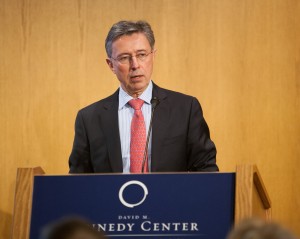Lord Chamberlain Ove Ullerup of Denmark presented the role of the Danish monarchy in the modern world for a Kennedy Center lecture on May 5, 2014.
Ullerup is a Danish lawyer and ambassador who was born near Jutland, Denmark, to a family with no links to nobility.
“I don’t know why I got my job,” Ullerup said. However, clearly he was prepared for the position as he started his presentation with the impressive history of the Danish monarchy, tracing it back to 958 A.D.

Denmark is one of the oldest monarchies in the world, but their system has changed several times over the past several centuries. For instance, in 1953 the monarch was blessed with three daughters and no sons, but “The Danish Act of Succession,” signed in 1953, made it possible for a female monarch to rule, as Queen Margrethe II does today.
Ullerup then discussed the constitutional and representative duties of Her Majesty, which include staying close to the legislative procedures and meeting with the prime minister weekly. The queen also decides on whom decorations are presented, but “not decorations in terms of your home,” Ullerup said.
Once a year the queen gives a New Year’s address, Ullerup describing the moment as, “the only time a year where the country comes to a standstill.”
Usually this speech focuses on ethics and morale rather than politics, as the queen is supposed to be politically neutral. He explained how difficult the balance is “between making a difference and not having a political standpoint.”
Regardless of the situation they are placed in, members the Denmark’s royal house try their best to make sure the queen is always representing the citizens of the country. The queen is not haunted by the media as much as in other countries, but the relationship is difficult to maintain. They try to have a longer perspective instead of destabilizing themselves by a story in the paper.
After presenting the responsibilities of the queen, Ullerup mentioned how the country was doing in terms of approval rate.
“I’m biased,” he said. However, according to several records, the approval rate of Her Majesty ranges from 80 to 90 percent.
The Lord Chamberlain also revealed how much it cost to run a royal house. Somewhere around $20 million is given annually to fund all of the personnel working within the royal house’s reach. Ullerup explained how this seems like a huge figure from a personal standpoint; however, from a business standpoint with 135 members, the number seems more reasonable. In comparison to other countries they are a bit less expensive, even after their indirect costs of $45 million are added.
The royal house is a symbol of Denmark; it has a strong link to roots of traders and travelers. Members of the royal house try to be involved on a worldwide level, Ullerup commenting that they have even affected Utah, as he has never seen so many Christensens and Petersons.
The Danish monarchy presents an interesting platform that focuses less on “how can you best serve us?” and more on, “how we can best serve you.”




